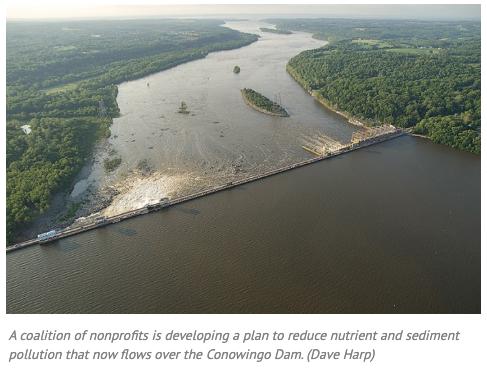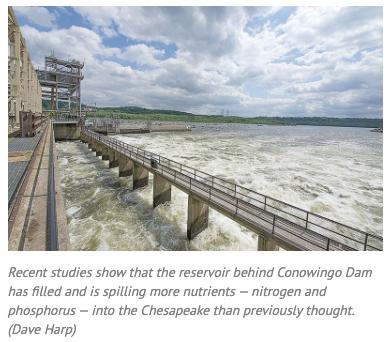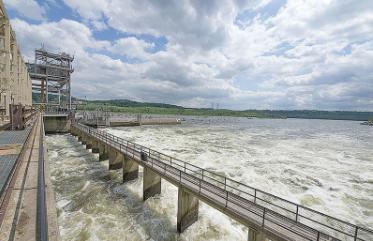 A coalition of nonprofits is developing a plan to reduce nutrient and sediment pollution that now flows over the Conowingo Dam. (Dave Harp)
A coalition of nonprofits is developing a plan to reduce nutrient and sediment pollution that now flows over the Conowingo Dam. (Dave Harp)
- Write and enact a plan to eliminate millions of pounds of nutrient pollution washing into waterways.
- Do it without duplicating the pollution reduction plans that states will be using to meet their own goals, which typically contain the cheapest and potentially most effective options.
- Oh, and come up with a way to pay for it, too.
Surprisingly, people have signed up for this seemingly impossible job. A coalition of nonprofits is developing a plan to reduce nutrient pollution to the Upper Bay to offset the impact of the Conowingo Dam — and to pay for it.
They hope to identify highly effective ways to reduce agricultural and stormwater runoff, which carries nutrients into waterways, and use them in places not already being targeted by states for Bay cleanup efforts. They also aim to tap new funding sources, including the private sector, to help pay for the plan.
“It is certainly a challenge,” said Byran Seipp, a watershed manager with the Center for Watershed Protection who is helping to coordinate the effort. “There is no doubt about that. It is something people have been wrestling with for quite a long time.”
The 94-foot-high Conowingo Dam, located just 10 miles up the Susquehanna River from the Chesapeake, has been casting a shadow over Bay cleanup efforts for years. Scientists had long known that once its 14-mile-long reservoir was filled, it would no long trap pollutants and they would begin to flow downstream.
But that day of reckoning was thought to be far in the future — at least past the 2025 Bay cleanup goal. As a result, impacts from the filled reservoir were not factored in when the U.S. Environmental Protection Agency assigned nutrient reduction goals to states in 2010.
Recent studies, though, determined that the reservoir has filled and is spilling more nutrients — nitrogen and phosphorus — into the Chesapeake than previously thought.
Computer models estimate that an additional 6 million pounds of nitrogen and 260,000 pounds of phosphorus would need to be controlled to make up for the dam’s lost trapping capacity. That would require roughly 15% more nutrient reductions beyond the stated 2025 cleanup goals — more than some states in the region have to accomplish individually.
With states already struggling to meet those goals, the state-federal Bay Program partnership last year decided to seek proposals from outside parties to develop a strategy to make up that gap.
Proposals were collected earlier this year, and the EPA recently awarded grants totaling nearly $600,000 to the Center for Watershed Protection, Chesapeake Bay Trust and Chesapeake Conservancy to tackle the job. They, in turn, will enlist the support of nearly a dozen other nonprofits, university partners and private sector consultants.
They’ll be working in partnership with a steering committee of state and federal representatives to coordinate the effort and ensure that their plan does not rely on practices states are counting on to meet their own cleanup goals.
The hope is that the Conowingo group will bring new insights that help tackle problems where progress has been elusive.
While the region has succeeded in reducing nutrient pollution from wastewater treatment plants, which can be addressed through regulation and technology, it has struggled to reduce nutrient-laden runoff from farms and developed lands. Progress remains far off the pace required to meet Bay water quality goals.
The Conowingo team will look to new high tech tools, new ideas and new financing strategies to accelerate progress.
“There is a real opportunity to create a sort of case study of how these states can come together to solve these basinwide issues in a cost-effective way,” Seipp said.
One of the first tasks is determining, geographically, the best places for making additional nutrient reductions. While the dam is located on the Susquehanna, reductions from nearby areas of Maryland’s Eastern and Western shores would have similar impacts on Bay water quality. The group is working with computer modelers to more precisely identify those areas.
The ability to explore that type of question is one reason that this plan will be unique. Unlike states, which are constrained to reducing nutrients within their borders, the Conowingo team can make reductions across jurisdictional borders.
Once those regions are identified, the team will use high-resolution satellite data and other tools to identify more precisely specific sites where runoff control practices will have the greatest benefit to water quality.
Many state and federal cost-share programs tend to rely on farmers signing up on their own to participate. By identifying specific sites, or groups of farms, they envision using more proactive outreach to targeted groups of farmers and other landowners, based on priority locations.
“It is not working an acre here and acre there,” said Jeff Allenby, director of conservation technology with the Chesapeake Conservancy. “You can actually put together some significant initiatives that achieve larger results than they would if you were just working project by project.”
The team also will explore barriers, whether financial, technical or cultural, to different nutrient reduction techniques. Some stream restorations, for example, meet resistance from landowners or local governments because the work requires more land than they are willing to make available or can acquire. The new tools can help identify opportunities for such projects that require less land.
Allenby said the group also might identify effective but underused manure treatment technologies to try to figure out how to boost their adoption.
Ultimately, though, the effort will require more money.
Some could come from Exelon, the utility that owns the dam. The state of Maryland recently announced an agreement with Exelon, in which the company will pay $200 million toward pollution reduction and habitat improvements over the next 50 years.
Even so, the Conowingo plan will require more money and creative ways to find it. A group of financial advisers will be recommending ideas, including private sector involvement.
One possibility is to view some agricultural efforts as infrastructure projects, and fund them through bonds. That would bring money to address problems more quickly, but allow those improvements to be paid off over time.
Also, the plan will likely involve the use of nutrient “trading,” and other market-based tools that encourage private investors to install nutrient control practices for credits that can be sold to jurisdictions or businesses needing to offset pollution impacts in other places. And that needs to happen across state borders, said Dan Nees of the University of Maryland Center for Global Sustainability.
“Somehow, we have to agree that geopolitical boundaries are not going to work when it comes to finance,” Nees said. “There needs to be an opportunity for revenue to flow back and forth where it has the greatest economic value, and that is through markets and water quality trading.”
Such techniques have been talked about for years in the Bay region, but have never had widespread adoption. Because of its cross-border approach, Nees said the Conowingo plan is ideally suited to pilot such concepts.
“We’ve been talking about this for too long,” Nees said. “We have to actually do it.”
A draft strategy is expected by March, with a final plan in June.
There is one key difference between the Conowingo cleanup plan and those written by the states. The EPA can take action against the states if their plans fall short, because they are legally required to meet Bay water quality standards. There’s no such legal requirement for the groups working on the Conowingo plan.
“We are working toward being able to devise a plan and have the funding to implement it and the tools to track it,” Seipp said. “But if that doesn’t happen, the people who ultimately hold the regulatory responsibility is the states.”



Write a Letter to the Editor on this Article
We encourage readers to offer their point of view on this article by submitting the following form. Editing is sometimes necessary and is done at the discretion of the editorial staff.